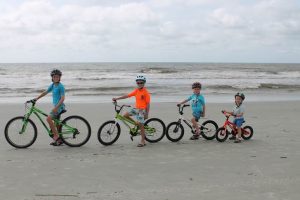By Lynn Pantuosco-Hensch, D.P.E. & Paula Welch, M.P.A.
May means longer days, warmer temperatures, and a multitude of opportunities to increase family fitness. To celebrate SHAPE America’s National Physical Education and Sport Week from May 1-7, here are some tips that professionals and educators can share with families to get them more involved in fitness.
Family First
Health professionals and educators can encourage families to be more physically active by emphasizing a variety of activities and ways to stay motivated, and by identifying opportunities for families to be active together. Learning to be physically active is like any other behavior: children learn by observing, and parents are children’s first and often best role models. Because the foundation for lifetime fitness is built in childhood, making family fitness a priority early on can yield results for years to come. Regardless of age and experience, it’s never too late to promote family fitness.
Team and individual activities are great, but being active with family is even better. The Physical Activity Guidelines for Americans and SHAPE America recommend 60 minutes of daily physical activity for children; even 30 minutes a day can make a difference in a family’s health and well-being. Busy parents will appreciate knowing that accumulating exercise throughout the day is valuable as well.
Change it Up
Encourage parents to have their children experiment with team and individual sports – variety is great for fitness and fun at all ages. Traditional team sports like soccer, baseball, and basketball are one option for introducing physical activity into a child’s life, but there is a growing trend toward participation in non-traditional or individual (and often lifetime) sports as well. Participation in a variety of team and individual sports throughout childhood can boost the chances for lifetime participation. Local park and recreation departments, YMCAs, and other private settings offer classes and lessons in many sports and fitness activities. Free trials, other beginner incentives, and family/group discounts can make experimenting more appealing and affordable.
Sample activities include:
- Biking
- Rowing
- Dance
- Golf
- Group exercise classes (e.g., barre, kickboxing, boot camp, Zumba)
- Parkour (e.g., obstacle courses)
- Rock climbing
- Running
- Skateboarding
- Swimming
- Yoga
Tip: Research and practical experience confirm that children, especially adolescents, are more likely to feel comfortable trying something new if they are with a friend. When a peer group is involved in a physical activity together, there is greater likelihood that the participants will remain committed. Encourage parents to get a group of their children’s friends together to try something new!
Measurement and Motivation
Some children are motivated by measuring and tracking their activity level. Technology can be integrated in a positive way with one of the many apps designed to record physical activity and track progress, or by using a simple pedometer or fitness tracker.
Independent physical activities to recommend include dog walking, exercise playing cards, desk cycles, exercise videos and fitness equipment (e.g., steps, resistance bands, physio-balls, and free weights). Remind parents that they know what motivates their children and can build on it.
Hit the Road
Advise parents to skip the treadmills and hit the pavement with the family. Walking together, either before school or after dinner, is a great chance to chat. Surprisingly, as few as 12 percent of American children walk or ride their bikes to school anymore. For those who live in communities with neighborhood schools, biking is another excellent way to get some movement in each day.
Go Somewhere New

Sometimes a change of scenery can keep exercise engaging and add variety for families. Professionals can encourage families to visit local parks, hiking trails, bike paths, tennis courts, driving ranges, and of course, the gym. Introducing adolescents to a local fitness center can also create enthusiasm for fitness.
Family vacations offer a great opportunity to try something new, whether it’s paddle boarding at the beach, mountain biking, or finding a nearby free park or playground. Encourage experimentation and variety.
Family Fitness
Professionals can remind parents that they don’t need to be star athletes to make family fitness happen. Spring is an opportune time for parents to help their kids start a neighborhood pick-up game of basketball or baseball outside. Kicking a ball around the yard or park, having a dance party in the kitchen during clean-up times, or challenging the kids to a who-can-do-the-most pushups contest (proper form trumps all!) are all activities that any parent can do. Children will love whatever fitness activity the family does together.
Family-based fitness has a greater likelihood of becoming lifelong fitness, with countless physical, cognitive, and social benefits. Health professionals and physical educators are uniquely qualified to teach people to get up, unplug, and get going. This week, promote fitness as a family affair!
Spread the word! Share this post with your network using this sample tweet: National PE & Sport Week is May 1-7! #HPE teachers will be celebrating in schools nationwide the benefits of being active! New @SHAPE_America #blogpost on getting the whole family active! #BigFeats https://bit.ly/2HnNHYZ